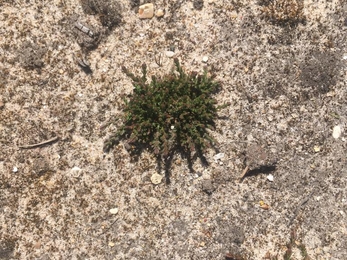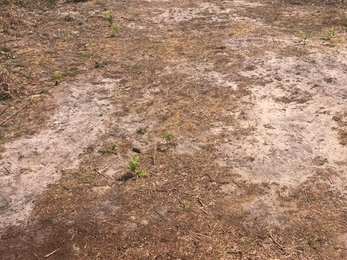Weekly wild news from our reserves, 26 June 2020
Red Admiral - Steve Aylward
Sulphur clover is a rare plant, found predominantly in unimproved grassland and it can be found growing alongside old roadside verges, but we are lucky to have it growing on two of our Suffolk Wildlife Trust reserves, Martins Meadow and Wink's Meadow. The plant is best seen flowering in June and July before the seeds ripen and the yellow flowers fade to brownish orange.
Prior to the seventeenth century the name ‘claver’ was more generally used than ‘clover’ which survives in many place-names, such as Clavering, Essex and Claverton in Somerset. Sulphur clover is a favourite with long-tongued bees, who have the ability to reach the nectar within the flowers.
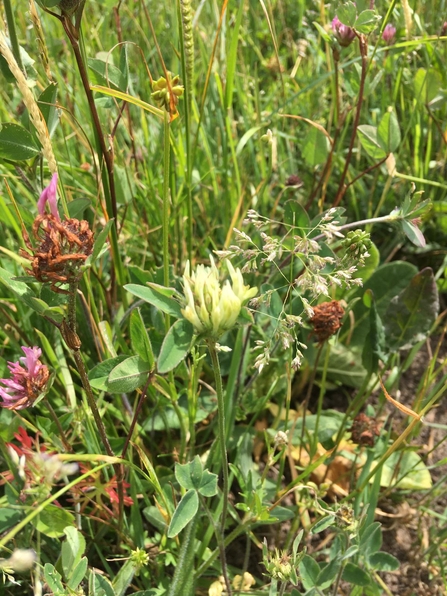
Sulphur clover - Ben Calvesbert
Dyer’s greenweed
Dyer's greenweed is a classic plant of hay meadows, heaths and open woodlands. It has upright stems with loose clusters of bright yellow, pea-like flowers that appear from June to August. It is an important food-plant for over 20 species of scarce moths not to mention other insects. Dyer's greenweed gets its common name from its traditional use in dying fabric where it would produce a vibrant yellow colour. The once famous ‘Kendal green’ was wool dyed yellow with greenweed and overdyed with woad or indigo.
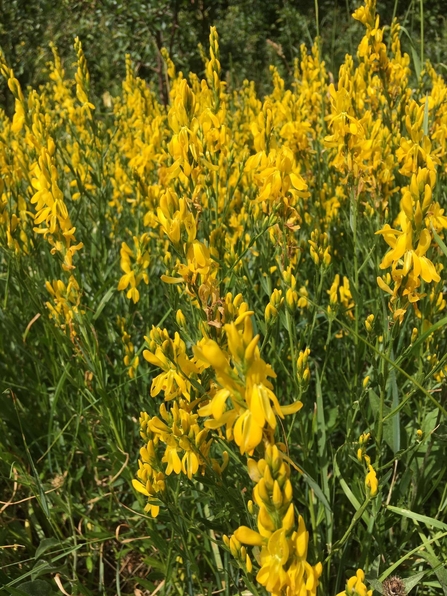
Dyer's greenweed - Ben Calvesbert
Our Hebridean sheep get to work at Newbourne Springs
Our newly shorn flock of Hebridean sheep have arrived safely at Newbourne Springs Nature Reserve to start the important role of conservation grazing. Thirty five hardy ewes are busy munching their way through fen vegetation, having completed this same valuable task on the heathland part of the site, in just one week due to the shortage of rain and vegetation growth. Grazing reduces biomass and nutrients from returning to the soil which ultimately benefits a wider range of species. Our flock will remain on the reserve until September, checked regularly by our team of stalwart volunteers.
Hebridean sheep arrive at Newbourne Springs (https://youtu.be/q02GR2Hc6gc)
Hebridean sheep arrive at Newbourne Springs
Heather regeneration
Gunton Warren is unique in Suffolk, as its one of the only remaining sections of the coast that has the full suite of habitats from mobile shingle, sand dunes, and vegetated cliff slopes to lowland heath on the cliff top.
Owned by East Suffolk Council, Suffolk Wildlife Trust has a 10-year management agreement to restore the habitat and improve community involvement. We have been working with local volunteers for several years to regenerate and restore the heathland by creating a patchwork of new heather plots suitable for invertebrates and reptiles like adders; the UK’s only venomous snake. Once established the heather will provide nesting sites for breeding birds.
The team have painstakingly cleared the bracken, gorse and a range of non-native invasive species that had taken over the area. Plots have been re-seeded with heather by hand, whilst other plots choked by bracken leaf litter have been scraped back to expose the bare soil beneath. These cleared plots were either re-seeded with heather by hand or left to naturally regenerate from original dormant heather seed now exposed to light. These little heather plants pictured below have germinated and grown over the last 2-3 years from the dormant seed.
Rare fen raft spider on three of Suffolk Wildlife Trust reserves
The fen raft spider (Dolomedes plantarius) is one of the UK’s rarest, largest and most spectacular spiders. It was not discovered in the UK until 1956 when eminent arachnologist Eric Duffey found it around the margins of peat pools at Redgrave and Lopham Fen, at the source of the River Waveney.
The spiders can literally walk on water and hunt for prey both at the water surface and underwater. They feed on a wide range of wetland invertebrates and can also take small amphibians and fish. The adult females lay eggs in a silk sac which they carry in their mouth parts for at least three weeks until the tiny spiderlings emerge. Although they don’t spin webs to catch their prey, they care for their young in a large tent-like nursery webs built in vegetation above the water
The very rare spiders can now be found at three of our reserves in Suffolk in the Waveney Valley and can be enjoyed from the viewing platforms and main paths with binoculars, a camera lens and sharp eyes! Because of their extreme rarity, fen raft spiders are fully protected by law. Therefore, we ask you to please keep strictly to the paths, with dogs on short leads, and away from the pond and dyke edges where the spiders can inadvertently be injured or killed by trampling.
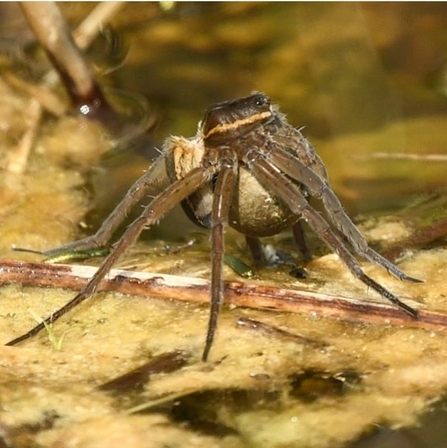
Fen Raft Spider - Sharon Broadly


